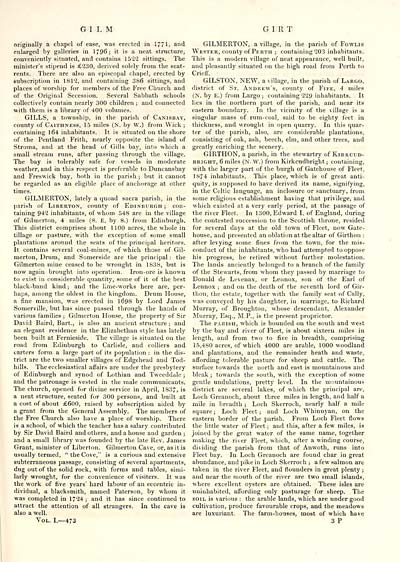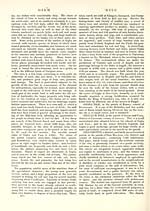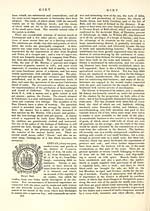Topographical dictionary of Scotland > Volume 1
(487) Page 473
Download files
Complete book:
Individual page:
Thumbnail gallery: Grid view | List view

G I L M
GIRT
originally a chapel of ease, was erected in 1771, and
enlarged by galleries in 1796; it is a neat structure,
conveniently situated, and contains 1522 sittings. The
minister's stipend is £230, derived solely from the seat-
rents. There are also an episcopal chapel, erected by
subscription in 1812, and containing 386 sittings, and
places of worship for members of the Free Church and
of the Original Secession. Several Sabbath schools
collectively contain nearly 300 children ; and connected
with them is a library of 400 volumes.
GILLS, a township, in the parish of Canisbay,
county of Caithness, 15 miles (N. by W.) from Wick ;
containing 164 inhabitants. It is situated on the shore
of the Pentland Frith, nearly opposite the island of
Stroma, and at the head of Gills bay, into which a
small stream runs, after passing through the village.
The bay is tolerably safe for vessels in moderate
weather, and in this respect is preferable to Duncansbay
and Freswick bay, both in the parish ; but it cannot
be regarded as an eligible place of anchorage at other
times.
GILMERTON, lately a quoad sacra parish, in the
parish of Liberton, county of Edinburgh ; con-
taining 942 inhabitants, of whom 548 are in the village
of Gilraerton, 4 miles (S. E. by S.) from Edinburgh.
This district comprises about 1 100 acres, the whole in
tillage or pasture, with the exception of some small
plantations around the seats of the principal heritors.
It contains several coal-mines, of which those of Gil-
merton, Drum, and Somerside are the principal : the
Gilmerton mine ceased to be wrought in 1838, but is
now again brought into operation. Iron-ore is known
to exist in considerable quantity, some of it of the best
black-band kind ; and the lime-works here are, per-
haps, among the oldest in the kingdom. Drum House,
a fine mansion, was erected in 1698 by Lord James
Somerville, but has since passed through the hands of
various families ; Gilmerton House, the property of Sir
David Baird, Bart., is also an ancient structure ; and
an elegant residence in the Elizabethan style has lately
been built at Fernieside. The village is situated on the
road from Edinburgh to Carlisle, and colliers and
carters form a large part of its population : in the dis-
trict are the two smaller villages of Edgehead and Tod-
hills. The ecclesiastical affairs are under the presbytery
of Edinburgh and synod of Lothian and Tvveeddale ;
and the patronage is vested in the male communicants.
The church, opened for divine service in April, 1S37, is
a neat structure, seated for 300 persons, and built at
a cost of about £600, raised by subscription aided by
a grant from the General Assembly. The members of
the Free Church also have a place of worship. There
is a school, of which the teacher has a salary contributed
by Sir David Baird and others, and a house and garden ;
and a small library was founded by the late Rev. James
Grant, minister of Liberton. Gilmerton Cave, or, as it is
usually termed, " the Cove," is a curious and extensive
subterraneous passage, consisting of several apartments,
dug out of the solid rock, with forms and tables, simi-
larly wrought, for the convenience of visiters. It was
the work of five years' hard labour of an eccentric in-
dividual, a blacksmith, named Paterson, by whom it
was completed in 1/24 ; and it has since continued to
attract the attention of all strangers. In the cave is
also a well.
Vol. I.— 473
GILMERTON, a village, in the parish of Fowlis
Wester, county of Perth ; containing 203 inhabitants.
This is a modern village of neat appearance, well built,
and pleasantly situated on the high road from Perth to
Crieff.
GILSTON, NEW, a village, in the parish of Largo,
district of St, Andrew's, county of Fife, 4 miles
(N. by E.) from Largo ; containing 229 inhabitants. It
lies in the northern part of the parish, and near its
eastern boundary. In the vicinity of the village is a
singular mass of rum-coal, said to be eighty feet in
thickness, and wrought in open quarry. In this quar-
ter of the parish, also, are considerable plantations,
consisting of oak, ash, beech, elm, and other trees, and
greatly enriching the scenery.
GIRTHON, a parish, in the stewartry of Kirkcud-
bright, 6 miles (N. W.) from Kirkcudbright ; containing,
with the larger part of the burgh of Gatehouse of Fleet,
1S74 inhabitants. This place, which is of great anti-
quity, is supposed to have derived its name, signifying,
in the Celtic language, an inclosure or sanctuary, from
some religious establishment having that privilege, and
which existed at a very early period, at the passage of
the river Fleet. In 1300, Edward I. of England, during
the contested succession to the Scottish throne, resided
for several days at the old town of Fleet, now Gate-
house, and presented an oblation at the altar of Girthon :
after levying some fines from the town, for the mis-
conduct of the inhabitants, who had attempted to oppose
his progress, he retired without further molestation.
The lands anciently belonged to a branch of the family
of the Stewarts, from whom they passed by marriage to
Donald de Levenax, or Lennox, son of the Earl of
Lennox ; and on the death of the seventh lord of Gir-
thon, the estate, together with the family seat of Cally,
was conveyed by his daughter, in marriage, to Richard
Murray, of Broughton, whose descendant, Alexander
Murray, Esq., M.P., is the present proprietor.
The parish, which is bounded on the south and west
by the bay and river of Fleet, is about sixteen miles in
length, and from two to five in breadth, comprising
15,4S0 acres, of which 4000 are arable, 1000 woodland
and plantations, and the remainder heath and waste,
affording tolerable pasture for sheep and cattle. The
surface towards the north and east is mountainous and
bleak ; towards the south, with the exception of some
gentle undulations, pretty level. In the mountainous
district are several lakes, of which the principal are,
Loch Greanoch, about three miles in length, and half a
mile in breadth ; Loch Skerroch, nearly half a mile
square ; Loch Fleet ; and Loch Whinnyan, on the
eastern border of the parish. From Loch Fleet flows
the little water of Fleet ; and this, after a few miles, is
joined by the great water of the same name, together
making the river Fleet, which, after a winding course,
dividing the parish from that of Anwoth, runs into
Fleet bay. In Loch Greanoch are found char in great
abundance, and pike in Loch Skerroch ; a few salmon are
taken in the river Fleet, and flounders in great plenty ;
and near the mouth of the river are two small islands,
where excellent oysters are obtained. These isles are
uninhabited, affording only pasturage for sheep. The
soil is various : the arable lands, which are under good
cultivation, produce favourable crops, and the meadows
are luxuriant. The farm-houses, most of which have
3P
GIRT
originally a chapel of ease, was erected in 1771, and
enlarged by galleries in 1796; it is a neat structure,
conveniently situated, and contains 1522 sittings. The
minister's stipend is £230, derived solely from the seat-
rents. There are also an episcopal chapel, erected by
subscription in 1812, and containing 386 sittings, and
places of worship for members of the Free Church and
of the Original Secession. Several Sabbath schools
collectively contain nearly 300 children ; and connected
with them is a library of 400 volumes.
GILLS, a township, in the parish of Canisbay,
county of Caithness, 15 miles (N. by W.) from Wick ;
containing 164 inhabitants. It is situated on the shore
of the Pentland Frith, nearly opposite the island of
Stroma, and at the head of Gills bay, into which a
small stream runs, after passing through the village.
The bay is tolerably safe for vessels in moderate
weather, and in this respect is preferable to Duncansbay
and Freswick bay, both in the parish ; but it cannot
be regarded as an eligible place of anchorage at other
times.
GILMERTON, lately a quoad sacra parish, in the
parish of Liberton, county of Edinburgh ; con-
taining 942 inhabitants, of whom 548 are in the village
of Gilraerton, 4 miles (S. E. by S.) from Edinburgh.
This district comprises about 1 100 acres, the whole in
tillage or pasture, with the exception of some small
plantations around the seats of the principal heritors.
It contains several coal-mines, of which those of Gil-
merton, Drum, and Somerside are the principal : the
Gilmerton mine ceased to be wrought in 1838, but is
now again brought into operation. Iron-ore is known
to exist in considerable quantity, some of it of the best
black-band kind ; and the lime-works here are, per-
haps, among the oldest in the kingdom. Drum House,
a fine mansion, was erected in 1698 by Lord James
Somerville, but has since passed through the hands of
various families ; Gilmerton House, the property of Sir
David Baird, Bart., is also an ancient structure ; and
an elegant residence in the Elizabethan style has lately
been built at Fernieside. The village is situated on the
road from Edinburgh to Carlisle, and colliers and
carters form a large part of its population : in the dis-
trict are the two smaller villages of Edgehead and Tod-
hills. The ecclesiastical affairs are under the presbytery
of Edinburgh and synod of Lothian and Tvveeddale ;
and the patronage is vested in the male communicants.
The church, opened for divine service in April, 1S37, is
a neat structure, seated for 300 persons, and built at
a cost of about £600, raised by subscription aided by
a grant from the General Assembly. The members of
the Free Church also have a place of worship. There
is a school, of which the teacher has a salary contributed
by Sir David Baird and others, and a house and garden ;
and a small library was founded by the late Rev. James
Grant, minister of Liberton. Gilmerton Cave, or, as it is
usually termed, " the Cove," is a curious and extensive
subterraneous passage, consisting of several apartments,
dug out of the solid rock, with forms and tables, simi-
larly wrought, for the convenience of visiters. It was
the work of five years' hard labour of an eccentric in-
dividual, a blacksmith, named Paterson, by whom it
was completed in 1/24 ; and it has since continued to
attract the attention of all strangers. In the cave is
also a well.
Vol. I.— 473
GILMERTON, a village, in the parish of Fowlis
Wester, county of Perth ; containing 203 inhabitants.
This is a modern village of neat appearance, well built,
and pleasantly situated on the high road from Perth to
Crieff.
GILSTON, NEW, a village, in the parish of Largo,
district of St, Andrew's, county of Fife, 4 miles
(N. by E.) from Largo ; containing 229 inhabitants. It
lies in the northern part of the parish, and near its
eastern boundary. In the vicinity of the village is a
singular mass of rum-coal, said to be eighty feet in
thickness, and wrought in open quarry. In this quar-
ter of the parish, also, are considerable plantations,
consisting of oak, ash, beech, elm, and other trees, and
greatly enriching the scenery.
GIRTHON, a parish, in the stewartry of Kirkcud-
bright, 6 miles (N. W.) from Kirkcudbright ; containing,
with the larger part of the burgh of Gatehouse of Fleet,
1S74 inhabitants. This place, which is of great anti-
quity, is supposed to have derived its name, signifying,
in the Celtic language, an inclosure or sanctuary, from
some religious establishment having that privilege, and
which existed at a very early period, at the passage of
the river Fleet. In 1300, Edward I. of England, during
the contested succession to the Scottish throne, resided
for several days at the old town of Fleet, now Gate-
house, and presented an oblation at the altar of Girthon :
after levying some fines from the town, for the mis-
conduct of the inhabitants, who had attempted to oppose
his progress, he retired without further molestation.
The lands anciently belonged to a branch of the family
of the Stewarts, from whom they passed by marriage to
Donald de Levenax, or Lennox, son of the Earl of
Lennox ; and on the death of the seventh lord of Gir-
thon, the estate, together with the family seat of Cally,
was conveyed by his daughter, in marriage, to Richard
Murray, of Broughton, whose descendant, Alexander
Murray, Esq., M.P., is the present proprietor.
The parish, which is bounded on the south and west
by the bay and river of Fleet, is about sixteen miles in
length, and from two to five in breadth, comprising
15,4S0 acres, of which 4000 are arable, 1000 woodland
and plantations, and the remainder heath and waste,
affording tolerable pasture for sheep and cattle. The
surface towards the north and east is mountainous and
bleak ; towards the south, with the exception of some
gentle undulations, pretty level. In the mountainous
district are several lakes, of which the principal are,
Loch Greanoch, about three miles in length, and half a
mile in breadth ; Loch Skerroch, nearly half a mile
square ; Loch Fleet ; and Loch Whinnyan, on the
eastern border of the parish. From Loch Fleet flows
the little water of Fleet ; and this, after a few miles, is
joined by the great water of the same name, together
making the river Fleet, which, after a winding course,
dividing the parish from that of Anwoth, runs into
Fleet bay. In Loch Greanoch are found char in great
abundance, and pike in Loch Skerroch ; a few salmon are
taken in the river Fleet, and flounders in great plenty ;
and near the mouth of the river are two small islands,
where excellent oysters are obtained. These isles are
uninhabited, affording only pasturage for sheep. The
soil is various : the arable lands, which are under good
cultivation, produce favourable crops, and the meadows
are luxuriant. The farm-houses, most of which have
3P
Set display mode to: Large image | Transcription
Images and transcriptions on this page, including medium image downloads, may be used under the Creative Commons Attribution 4.0 International Licence unless otherwise stated. ![]()
| Gazetteers of Scotland, 1803-1901 > Topographical dictionary of Scotland > Volume 1 > (487) Page 473 |
|---|
| Permanent URL | https://digital.nls.uk/97487878 |
|---|
| Description | Volume I: From Abbey to Jura. |
|---|---|
| Attribution and copyright: |
|

